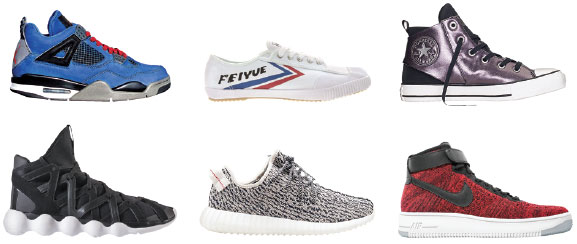The rise of sneaker culture
By China Daily ( China Daily ) Updated: 2017-06-24 07:07:55
 |
|
Clockwise from top left: Air Jordan 4 Retro "Eminem Encore", Nike; Fe Lo Classic White, Feiyue; Chuck Taylor All Star Sloane, Converse; Air Force 1 Ultra Flyknit, Nike; Yeezy Boost 350, Adidas; Kyujo High, Y-3. Photos Provided To China Daily |
Sneakers have evolved over time from functional sportswear to top status symbols
According to the Census and Statistics Department of Hong Kong, the retail sales of sneakers in the city reached HK$436.6 billion last year. The dynamic Mong Kok shopping district has opened its arms to thousands of visitors every day, maps in hand as many try to locate "Sneakers Street" (on Fa Yuen Street) in this densely packed area.
Meanwhile, on Instagram, the popular sneaker-related hashtag #yeezy continues to run the show, with more than five million mentions. It started in 2009, when hip-hop artist Kanye West launched his sneaker collection with Louis Vuitton, then the Air Yeezy with Nike the same year, followed by the Air Yeezy 2 in 2012. However, in 2015, he switched over to Adidas and introduced the Yeezy Boost 750 and 350, both unquestionably the most-wanted kicks among "sneakerheads" (avid collectors) that year - and they're still highly sought after. The former was limited to 9,000 pairs worldwide and sold out in 10 minutes.
The first "sneakers" (though they weren't named that yet) debuted in the 1860s. Made of leather and spikes, they were introduced as the first specialized running shoes by British company Thomas Dutton and Thorowgood. In 1892, the US Rubber Company introduced a pair of rubber shoes with canvas tops called Keds. The company mass-produced them in 1916 and an advertising agent nicknamed them "sneakers" to suggest how quiet they were due to their rubber soles.
In 1917, the Converse Rubber Shoe Company introduced the prototype of the All Star; the famous name wasn't adopted until basketball player Chuck Taylor became aligned with the brand.
He joined the Converse sales force in 1921, then became a player and coach for the company's basketball team, the Converse All Stars. Taylor saw his name added to the ankle patch, which he had helped develop for better support, and the shoe ultimately named for him as a token of appreciation. In the 1960s, some 90 percent of university and professional basketball players in the US wore the Converse Chuck Taylor All Stars.
Confused about the big difference between sneakers and trainers? Many use the terms interchangeably, but there actually is a difference; the former are athletic-based shoes and are usually worn more for fashion, while the latter are named as a short form for "training shoes" and are aimed at improving performance in a specific athletic activity, such as running or weightlifting.
Aside from Kanye West, top fashion designers have also collaborated with sports brands to present collections as sneakers move into the world of high fashion. As an example, for autumn 2016, Raf Simons released his reinterpretation of Adidas' iconic Stan Smith sneakers; the classic "three stripes" on the side were replaced with the designer's perforated "R" logo and a more luxurious, minimalist approach. Also with Adidas, Stella McCartney has been designing sneakers, trainers and other gym wear for women since 2005.
Founded in Shanghai in the 1920s, the nostalgic martial arts-suitable shoe brand Feiyue flew across Chinese borders in 2006 (its name, indeed, means "flying forward") and landed in France. Whether it was or wasn't officially licensed, its unique retro style, coupled with a fresh French redesign, caught the eyes of Europe and launched a new obsession that was unprecedented in China.
The present-day sneaker culture has evolved to combine not only athletics and fashion, but also the omnipresent marketing and business angles. For most sneakerheads, it's about the hardest-tofind pairs. Since the 1980s, they've come to Mong Kok from all over the world to source sought-after shoes at low-tax prices. Fanatics camp out for rare new releases, while others buy through resellers, sometimes paying 10 times or more compared to the retail price.
Globally, limited-edition sneakers are a definite status symbol for those who are willing to pay. One high-end sneaker reseller in Los Angeles shared his recent deals, which included the sale of a pair of Nike Air Jordan 4 Retro "Eminem Encore" for US$30,000 - only 50 pairs were made at an original retail price of US$180.
A Beijing-based sneakerhead who regularly shops for limited editions, Tianyi recalled the first time he started to save up for a pair of Adidas T-Macs (named for basketball star Tracy McGrady) when he was 13 years old.
This was 10 years ago and he was the only kid in school with the shoes' iconic black and red design. From that moment, he became fascinated by the irreplaceable thrill of standing out from his peers.
However, in the past decade, things have changed. "Now, when you visit a middle or high school in Beijing, you see a bunch of boys wearing Yeezy," he says. "It's definitely a scene now." No matter whether as a wardrobe staple or a status symbol, sneakers have become truly essential - put your best foot forward.
|
|
|
|
|
|
|
|

























 Raymond Zhou:
Raymond Zhou: Pauline D Loh:
Pauline D Loh: Hot Pot
Hot Pot Eco China
Eco China China Dream
China Dream China Face
China Face






